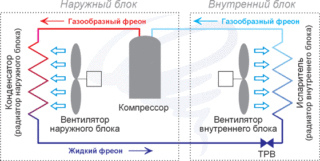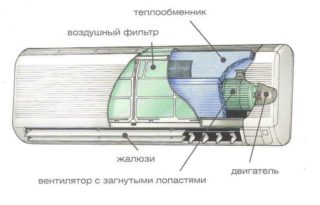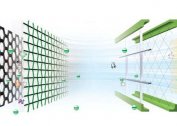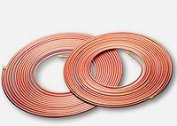The evaporator helps the refrigerant to draw heat from the air as it evaporates inside the circuit. In a monoblock, it is located next to the capacitor, and in a split system in an indoor unit.
Operating principle
The main function of the evaporator is the cooling of the air flow driven through the fan. The evaporator is a mandatory part of the closed freon circle.
The composition of the cooling and heating system:
- refrigerant;
- evaporator;
- fans of indoor and outdoor units;
- copper piping for refrigerant;
- capacitor;
- compressor;
- compressor oil;
- thermostatic valve.
Freon, which is initially in a gaseous state, is compressed in a compressor and turns into a liquid. The air that enters the device due to the fan, freon gives off its heat.
The liquid enters the thermostatic valve, having previously reset part of the temperature. The refrigerant, having received reduced pressure inside the spiral device, is cooled even more.
Once in the evaporator, freon again returns to the gaseous state when interacting with room air, cooling the space of the room. The circulation is due to the operation of the fan.
Varieties of heat exchangers and their arrangement
Evaporative heat exchangers are divided into 2 types.
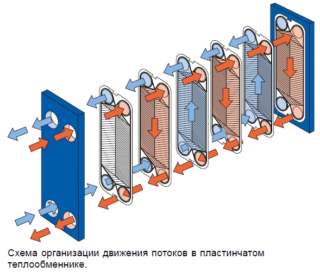 The first type: lamellar. Between adjacent plates are channels for the circulation of air entering from the street and refrigerant.
The first type: lamellar. Between adjacent plates are channels for the circulation of air entering from the street and refrigerant.
Subtypes of plate heat exchangers:
- multi-circuit - has on one side of the plate two separate contours;
- one-way - the movement of the cooling medium only down, and the evaporating freon - up;
- multi-way - the direction of movement can change several times
The second type: shell-and-tube heat exchangers. The metal pipes installed in the casing are placed in the form of a spiral tape or bundles fixed inside the pipes, chambers, covers, casing. Most often, copper is used as the material.
Shell-and-tube heat exchangers are divided into several types:
| By refrigerant | Ammonia | Freon | – |
| By pipe arrangement | Vertical | Horizontal | – |
| According to the structure of pipes | Ribbed | Smooth | – |
| By the number of rows of pipes | Single row | Double row | Beam |
Evaporator Malfunctions
The most common problem is the cessation of air cooling. In most cases, this happens due to the accumulation of dust and dirt, as they prevent air from entering the heat exchange surface.
Contamination is also dangerous for other parts of the cooling system - during prolonged operation in inappropriate conditions, the compressor often burns out.
The air conditioner evaporator can be covered with a layer of ice, and then the melting water, overflowing the drainage tank, will pour into the room. This situation occurs due to depressurization of the circuit and leakage of freon. In case of such a serious breakdown, it is recommended to contact a service center.
The air conditioner and evaporator in particular may not work properly due to improper installation of the system. Therefore, if there is no personal experience in the repair and installation of air conditioners, you should not take up the matter yourself. It is necessary to entrust the work to professionals.
A fan that starts to fail and works too weakly also affects the performance of the entire heat exchange system.
Equipment cleaning
Cleaning the air conditioner is carried out at least 2 times a year - in spring and autumn.Animal hair and too dirty or humid air, contributing to the appearance of fungi and mold, quickly lead the device to a critical state. In the presence of these factors, cleaning is carried out at least once every 3 months.
Signals of severe clogging:
- cooling properties have deteriorated;
- the power of the air conditioner has decreased, and energy consumption has increased;
- When you turn on the device, an unpleasant odor appears.
For the cleaning procedure, you can call a professional or get down to business on your own - the process is not too complicated.
Cleaning scheme
Cleaning products are available in the form of foam or aerosol. They have disinfecting properties, contain biologically active components, alkaline additives and acids. They should be used according to the instructions on the packaging.
Chlorhexidine will help save on special cleaning products. It effectively copes with dirt, fungi and bacteria, and its price is much lower. It is used in medicine as an antiseptic solution. You can purchase at any pharmacy.
Self-cleaning the heat exchanger involves several steps.
Disconnect the device from the power supply. For greater safety, turn off the power to the apartment during the operation.
Open the front panel and remove the air filters. Rinse the coarse filter under warm running water and let it dry. Hot water and forced drying with hot air should not be used, as the filter screen may be deformed.
Depending on the air conditioner model, the evaporator is located under the filters or under the cover. Clean carefully to avoid damage to the device. A vacuum cleaner with a narrow hose nozzle is recommended.
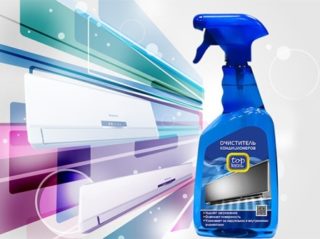 Carefully collect any accumulated dust from the heat exchanger. Then use detergent. The best choice for cleaning the evaporator will be a spray due to its ease of use. Spray the spray on the heat exchanger until the product begins to drip from it. Stop, wait 5 minutes and spray again.
Carefully collect any accumulated dust from the heat exchanger. Then use detergent. The best choice for cleaning the evaporator will be a spray due to its ease of use. Spray the spray on the heat exchanger until the product begins to drip from it. Stop, wait 5 minutes and spray again.
Carefully wipe away any residual detergent from the cabinet and tubes. Do not wipe the heat exchanger - there is a high probability of accidentally deforming the lamellas. The tool itself gradually drains naturally.
Replace all removed parts. The filter can be inserted when it is completely dry. Resume power and turn on the air conditioner.
If the device is too dirty due to a lack of maintenance for a long time, contact the service. In critical condition, conventional cleaning agents may not be able to cope with the task. Professionals most often use a steam generator to combat stubborn dirt.
Service prices
Service for the repair and maintenance of air conditioners takes a lot of money for their work. To guide this issue, the average prices in Moscow for several services were analyzed:
| Type of service | Minimum price (in rubles) |
| Drainage system cleaning | 500 |
| Dry cleaning of the outdoor unit capacitor | 1300 |
| Cleaning the fan blades of the indoor unit | 1400 |
| Cleaning the evaporator of the indoor unit with an antibacterial composition | 1500 |
| Cleaning the condenser of the outdoor unit with a washer | 3000 |
The evaporator is an important part in the operation of the air conditioner, so timely maintenance will allow it to function for many years without breakdowns.
